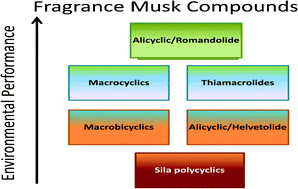The design of the molecule itself is the earliest phase in the process of developing useful products. Two of the 12 green chemistry principles, which state that chemicals should be designed to have minimal toxicity and degrade environmentally to innocuous products, are central to chemical design. Previously we used a series of case studies to show that generalizations about the effects of molecular structure can be used to design small molecules for biodegradability. Here, we extend one of the case studies (synthetic musk fragrances) to a wider range of structures, and address all three PBT properties (persistence, bioaccumulation, toxicity). To this end, we first summarize ready biodegradation and aquatic toxicity data for musks including unpublished data from US Premanufacture Notice (PMN) chemicals. Bioaccumulation potential is then estimated for this set of musks using EPA's BCFBAF© (a component of EPI Suite©), KOAWIN© and ECOSAR© programs, and the results are used to compare musks across the various structural classes and make inferences about their environmental attributes. Last, the analysis is extended to target molecules. In this way we show how predictive methods and knowledge can be included as additional facets in rational design of small molecules.

You have access to this article
 Please wait while we load your content...
Something went wrong. Try again?
Please wait while we load your content...
Something went wrong. Try again?


 Please wait while we load your content...
Please wait while we load your content...